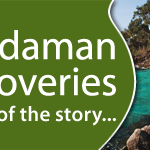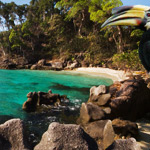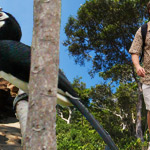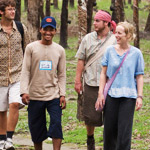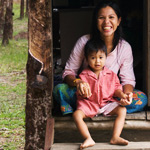Andaman Discoveries Blog
Friday, July 3, 2009
Erik's Adventures - Mangrove Planting in Tung Dap
 From Tung La Ong pier, the departure point from the mainland, the light of dawn shimmered off the dense mist draped over the distant mountains, coating the rainforest with what looked like a rippled layer of icing. Two festively-painted fishing boats idled nearby while women perfunctorily sorted the previous night’s catch. Here I met Nu, my boat driver, a quiet but amiable young man with a shock of jet-black hair that he wears in the rough-cut mullet style currently in vogue in Thai pop culture. With a vigorous crank, our traditional longtail’s engine came to life in a piercing fit, and soon Nu was expertly ferrying us over the tranquil waters of the Andaman Sea towards the southwestern tip of Koh Phratong, home of the fishing village of Tung Dap.
From Tung La Ong pier, the departure point from the mainland, the light of dawn shimmered off the dense mist draped over the distant mountains, coating the rainforest with what looked like a rippled layer of icing. Two festively-painted fishing boats idled nearby while women perfunctorily sorted the previous night’s catch. Here I met Nu, my boat driver, a quiet but amiable young man with a shock of jet-black hair that he wears in the rough-cut mullet style currently in vogue in Thai pop culture. With a vigorous crank, our traditional longtail’s engine came to life in a piercing fit, and soon Nu was expertly ferrying us over the tranquil waters of the Andaman Sea towards the southwestern tip of Koh Phratong, home of the fishing village of Tung Dap.Tung Dap was almost wholly leveled by the tsunami of December 2004, and particularly hard hit were its mangrove swamps. Although the village has since been rebuilt and life has largely returned to normal there, the work of restoring the mangroves, a vital coastal buffer and ecosystem, continues.
We moored the boat just offshore and set upon our first task: retrieving several canvas sacks of mangrove seedlings. With the help of Nu I’d soon added useful new lexis to my budding Thai language skills: nok maak, which means very heavy! Indeed, gravity seemed to increase by an order of magnitude as we plodded through the fine, sediment-rich mud, and before it occurred to me to remove them, the sucking vacuum of each footstep simultaneously claimed both of my 35-Baht flip-flops.
 From there Nu piloted the boat to Tung Dap pier, where we were joined by his wife Pin, as well as Yui and Fen, who’d prepared a savory breakfast of squid in chili sauce, pickled eggs, and fresh vegetables accompanied by white rice -- the foundation of any Thai meal.
From there Nu piloted the boat to Tung Dap pier, where we were joined by his wife Pin, as well as Yui and Fen, who’d prepared a savory breakfast of squid in chili sauce, pickled eggs, and fresh vegetables accompanied by white rice -- the foundation of any Thai meal.With our team now assembled and sated, we leisurely reboarded the longtail and headed inland, navigating our way along a meandering river channel. More than two years after the tsunami, the evidence of destruction is still readily apparent here, with large swaths of denuded land still bearing testament to the wave’s destructive power.
Mangrove seedlings look a bit like unburned candles, varying in length from a few inches to over a foot, and ranging in hues of green similar to those of an avocado. These remarkable seedlings are germinated while still attached to the parent tree, and can produce their own food via photosynthesis. A mangrove seedling often travels great distances by water, and can actually alter its own density depending on whether it needs to float or upright itself to take root. Furthermore, it can survive desiccation and remain dormant for over a year until it arrives at a suitable environment in which to find purchase.
 Using my t-shirt as a basket, I loaded up several handfuls of seedlings and schlepped along the mucky shore. My instructions were simple: lodge each seedling about an inch or two into the ground, and make sure to space them a few feet apart; any seedlings that were missing a “wick” were no good.
Using my t-shirt as a basket, I loaded up several handfuls of seedlings and schlepped along the mucky shore. My instructions were simple: lodge each seedling about an inch or two into the ground, and make sure to space them a few feet apart; any seedlings that were missing a “wick” were no good.In bare feet, I constantly fought to mask the discomfort of traversing the prickly stubble of protruding sticks; I was already failing to keep pace the locals, with their obviously thicker-skinned soles. Three hours and a few scrapes and cuts later, we’d filled vast barren stretches of shoreline with seedlings, greatly facilitating the restoration of the coastal environment.
We then headed to a nearby beach where, with empty canvas sacks in hand, we embarked on our final mission for the day, which was to collect more seedlings. I’d previously assumed the seedlings were farmed or brought in from somewhere (as they are in all other mangrove reforestation programs in the Koh Phratong area), but it turns out they wash up in abundance along the beach -- in an hour we’d filled five sacks of them, which we left on the beach for tomorrow’s crew. I also found two mismatched but functional flip-flops amongst the flotsam and jetsam, greatly easing my trip back to Kuraburi.
Back at sea, Nu stopped the boat and Fen instructed me in English that “now we go swimming.” We playfully splashed around in the Andaman’s saline waters, liberating ourselves of mangrove mud and allowing the morning’s toil to slip away. The resilience of Tung Dap’s people struck me at this moment: from day one they’ve been steadfast in their determination to restore their lives and their village, and in a manner that’s respectful of the natural environment. Innocent laughter reverberated as we took turns hoisting one another into the water. Remarkably, in the face of everything it’s taken from them, the people of Tung Dap are at completely peace with the sea.
Labels: activities, ecotourism, habitat restoration, Hands-on, mangrove planting, tsunami, Tung Dap
Comments:
<< Home
zzzzz2018.8.7
pandora outlet
canada goose outlet
salomon
canada goose outlet
coach outlet online
moncler
ugg boots
moncler online outlet
louboutin shoes
moncler jackets
Post a Comment
pandora outlet
canada goose outlet
salomon
canada goose outlet
coach outlet online
moncler
ugg boots
moncler online outlet
louboutin shoes
moncler jackets
Subscribe to Post Comments [Atom]
<< Home
Subscribe to Comments [Atom]

